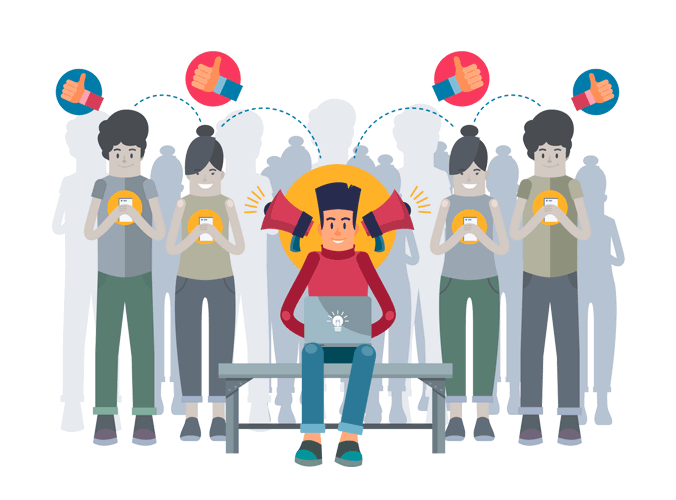With fame comes fortune. Is it true?
The internet is growing, and so is social media. An age old question about the internet is that, is it really worth your efforts to spend time and money to capture your audience? How much is needed?
The answer depends on your passion and drive. And of course, money.
Then there is the question, when will those efforts become profitable? How long should they keep going?
These questions are often asked, not only to individuals, but also to anyone including businesses that want to get into the influencer marketing industry.
So, who are these influencers? How much do they worth?

Influencers are those people with "influence." With their fame in their respective niche and industry, they form influence marketing which focuses in targeting specific audience, instead of a whole market. These influencers centers on compliance and persuasion in social environments, based on loose interactions between various parties in a community.
In short, they are promoters.
They have followers, which means, they have people who "listen" to them. What makes them "influencers" is that people "believe" in them. Their followers are actively consuming their contents, visiting links they post, watching their stories and buying their advice.
So what makes influencers, influencers?
First of all, and also the easiest way to define them, is by seeing their followers. How many do they have?
This metric is the most common to judge whether someone is an influencer or not. But no, it doesn't really indicate whether the person is a real influencer because some people with 500 followers can influence more people than those who have 5000 followers.
So follower count matters, but not always the case to indicate influencers.
The next metric, is engagement. This can be evaluated in a number of ways. For example, how many people are liking or commenting on the persons' posts? Influencers with 5000 followers are more likely to have higher engagement than those who have 500 followers.
Then there is reach. This important metric should be evaluated with engagement. For example, posts which get more eyes interested, should be followed by open-minded people who are curious. So if an influencer reaches 10,000 people but get only 10 clicks, this influencer may worth less than an influencer who reaches 5,000 people but also gets 10 clicks.
This is because the latter, is able to get their post in front of the right targeted audience.
How Many Do You Need To Become A Profitable Influencer?
Short answer: depends on how big people value you. The more you are valuable to your audience, the higher the chance you can attract brands. Long answer, depends on who the influencer really is.
There are several types of influencers:
Unintentional influencers
Let's say you are posting a food you're eating on social media, and a friend commented on it. This attracted more friends to comment, widening the posts' reach. Then someone recognizes the food and posted the name of the restaurant. And this restaurant suddenly gets more visitor because of it. This is called unintentional influencer.
If you are in this state, don't expect the restaurant to pay for your promotion. A compliment should be enough.
Soon-To-Be Influencers
This is the state for most people that are looking forward to become influencers themselves. These people are actively growing their fanbase, with the intention of profit, sponsorship, sales, recognition, advertisements, and so on.
In this state, you can ask for sponsorship and get some income. But don't expect a steady generous revenue because brands may still question your credibility. You may or may not been verified with the checkmark, for example. Or, your presence may still be limited to certain demographic, making your reach rather narrow and not targeted.

Popular Influencers
These people have follower count that racks up to tens of thousands, hundreds of thousands to millions and beyond. Their posts reach a lot of people, and they also capable in affecting the media industry. What they say matters because of their appeal to their niche audience.
In this state, you are paid because people value you. It depends on who you are, who are your fans, your portfolio, as well as your negotiating ability.
Celebrity Influencers
These people didn't choose to be influencers, but they became one as they come. Examples include the rich and famous, popular celebrities, powerful politicians, and others that give benefits to the society. What these people say, can give impact to the community and beyond. These people are certainly public figures, and they are famous wherever they are.
As for payments, the range varies widely. But in general, it's hefty.
Read: Engage With Influencers: Making You A Future Influencer Yourself
Summary
When defining social media influencers, the first thing that comes in mind is the number of followers. People with high follower count are most often considered as influencers, but really, this is not always the case. There are many so-called influencers that do have huge follower counts, but are less capable in engaging and reaching their audience.
It's no secret that many of those influencers buy their way up by spending money to get followers.
This is the reason why follower count is subjective.
What really matters for influencers to become influencers, is engagement and reach. These two metrics can define influencers way better. This is because influencers have authority, and should be able to generate quality posts wherever they are on the web. They can also connect with other influencers, furthering their reach.
Let's not forget about those people with a little follower count, but capable of having dedicated followers. These people post less often, but can really affect people on every post. These people are called "micro-influencers," and they have specific niche audiences which are deeply connected to them.